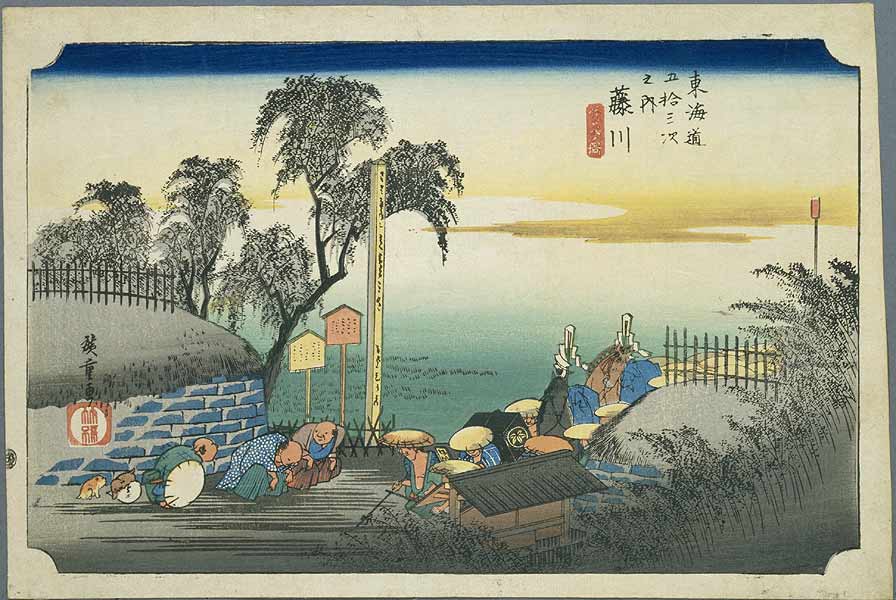Fujikawa-shuku on:
[Wikipedia]
[Google]
[Amazon]
 was the thirty-seventh of the fifty-three stations of the Tōkaidō. It is located in the present-day city of Okazaki, in
was the thirty-seventh of the fifty-three stations of the Tōkaidō. It is located in the present-day city of Okazaki, in
. Tōkaidō no Tabi. Accessed March 6, 2008. Another accepted reading for this post town is "Fujikawa-juku." At its peak, Fujikawa-juku was home to 302 buildings, including one '' honjin'', one sub-''honjin'' and 36 '' hatago''. Its total population was approximately 1,200 people. The classic
 was the thirty-seventh of the fifty-three stations of the Tōkaidō. It is located in the present-day city of Okazaki, in
was the thirty-seventh of the fifty-three stations of the Tōkaidō. It is located in the present-day city of Okazaki, in Aichi Prefecture
is a prefecture of Japan located in the Chūbu region of Honshū. Aichi Prefecture has a population of 7,552,873 () and a geographic area of with a population density of . Aichi Prefecture borders Mie Prefecture to the west, Gifu Prefectur ...
, Japan
Japan ( ja, 日本, or , and formally , ''Nihonkoku'') is an island country in East Asia. It is situated in the northwest Pacific Ocean, and is bordered on the west by the Sea of Japan, while extending from the Sea of Okhotsk in the north ...
. It was approximately from Akasaka-juku, the preceding post station.Tokaido 53: Fujikawa-juku (Okazaki). Tōkaidō no Tabi. Accessed March 6, 2008. Another accepted reading for this post town is "Fujikawa-juku." At its peak, Fujikawa-juku was home to 302 buildings, including one '' honjin'', one sub-''honjin'' and 36 '' hatago''. Its total population was approximately 1,200 people. The classic
ukiyo-e
Ukiyo-e is a genre of Japanese art which flourished from the 17th through 19th centuries. Its artists produced woodblock prints and paintings
Painting is the practice of applying paint, pigment, color or other medium to a solid surfac ...
print by Andō Hiroshige
Utagawa Hiroshige (, also ; ja, 歌川 広重 ), born Andō Tokutarō (; 1797 – 12 October 1858), was a Japanese ''ukiyo-e'' artist, considered the last great master of that tradition.
Hiroshige is best known for his horizontal-format l ...
(Hōeidō edition) from 1831 to 1834 depicts a ''daimyō
were powerful Japanese magnates, feudal lords who, from the 10th century to the early Meiji era, Meiji period in the middle 19th century, ruled most of Japan from their vast, hereditary land holdings. They were subordinate to the shogun and n ...
'' procession on ''sankin-kōtai
''Sankin-kōtai'' ( ja, 参覲交代/参覲交替, now commonly written as ja, 参勤交代/参勤交替, lit=alternate attendance, label=none) was a policy of the Tokugawa shogunate during most of the Edo period of Japanese history.Jansen, M ...
'' entering the post station, which would have been a common occurrence. Three commoners are shown as kneeling as the lord's retinue passes.
The Okazaki city government has been working actively on preserving this old post town as a tourist destination. In addition to creating the Fujikawa-shuku Archives Museum within the preserved waki-'' honjin'', detailing the history of the post town, the city has preserved a number of old structures such old street lights, and traditional houses with lattice windows. A line of old pine trees extending for approximately a kilometer marks the location of the Tōkaidō road.
Neighboring post towns
;Tōkaidō : Akasaka-juku - Fujikawa-shuku -Okazaki-shuku
was the thirty-eighth of the fifty-three stations of the Tōkaidō. It is located in the present-day city of Okazaki, in Aichi Prefecture, Japan.
History
Okazaki-shuku was a part of the flourishing castle town surrounding Okazaki Castle, t ...
Further reading
*Carey, Patrick. ''Rediscovering the Old Tokaido:In the Footsteps of Hiroshige''. Global Books UK (2000). *Chiba, Reiko. ''Hiroshige's Tokaido in Prints and Poetry''. Tuttle. (1982) *Taganau, Jilly. ''The Tokaido Road: Travelling and Representation in Edo and Meiji Japan''. RoutledgeCurzon (2004).References
{{coord, 34.911, 137.223, display=title, type:landmark_region:JP Stations of the Tōkaidō Stations of the Tōkaidō in Aichi Prefecture